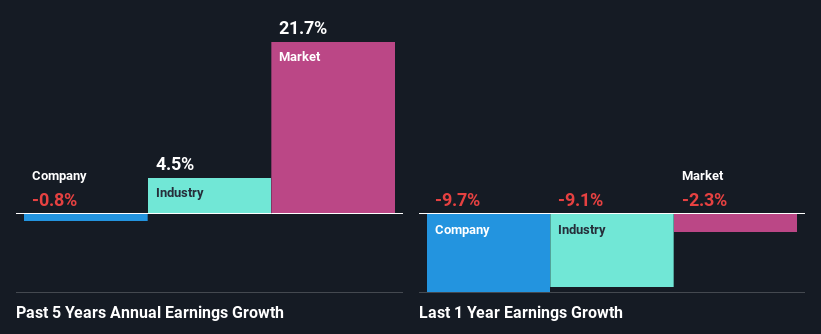Are Corby Spirit and Wine Limited's (TSE:CSW.A) Mixed Financials The Reason For Its Gloomy Performance on The Stock Market?
It is hard to get excited after looking at Corby Spirit and Wine's (TSE:CSW.A) recent performance, when its stock has declined 8.1% over the past three months. It seems that the market might have completely ignored the positive aspects of the company's fundamentals and decided to weigh-in more on the negative aspects. Stock prices are usually driven by a company’s financial performance over the long term, and therefore we decided to pay more attention to the company's financial performance. Particularly, we will be paying attention to Corby Spirit and Wine's ROE today.
Return on equity or ROE is a key measure used to assess how efficiently a company's management is utilizing the company's capital. Simply put, it is used to assess the profitability of a company in relation to its equity capital.
Check out our latest analysis for Corby Spirit and Wine
How Is ROE Calculated?
ROE can be calculated by using the formula:
Return on Equity = Net Profit (from continuing operations) ÷ Shareholders' Equity
So, based on the above formula, the ROE for Corby Spirit and Wine is:
13% = CA$23m ÷ CA$185m (Based on the trailing twelve months to March 2023).
The 'return' is the yearly profit. That means that for every CA$1 worth of shareholders' equity, the company generated CA$0.13 in profit.
What Has ROE Got To Do With Earnings Growth?
Thus far, we have learned that ROE measures how efficiently a company is generating its profits. Depending on how much of these profits the company reinvests or "retains", and how effectively it does so, we are then able to assess a company’s earnings growth potential. Assuming everything else remains unchanged, the higher the ROE and profit retention, the higher the growth rate of a company compared to companies that don't necessarily bear these characteristics.
Corby Spirit and Wine's Earnings Growth And 13% ROE
To start with, Corby Spirit and Wine's ROE looks acceptable. And on comparing with the industry, we found that the the average industry ROE is similar at 13%. However, we are curious as to how Corby Spirit and Wine's decent returns still resulted in flat growth for Corby Spirit and Wine in the past five years. So, there could be some other aspects that could potentially be preventing the company from growing. For example, it could be that the company has a high payout ratio or the business has allocated capital poorly, for instance.
We then compared Corby Spirit and Wine's net income growth with the industry and found that the average industry growth rate was 4.5% in the same 5-year period.
Earnings growth is a huge factor in stock valuation. It’s important for an investor to know whether the market has priced in the company's expected earnings growth (or decline). This then helps them determine if the stock is placed for a bright or bleak future. Is Corby Spirit and Wine fairly valued compared to other companies? These 3 valuation measures might help you decide.
Is Corby Spirit and Wine Efficiently Re-investing Its Profits?
The high three-year median payout ratio of 92% (meaning, the company retains only 8.0% of profits) for Corby Spirit and Wine suggests that the company's earnings growth was miniscule as a result of paying out a majority of its earnings.
In addition, Corby Spirit and Wine has been paying dividends over a period of at least ten years suggesting that keeping up dividend payments is way more important to the management even if it comes at the cost of business growth.
Conclusion
In total, we're a bit ambivalent about Corby Spirit and Wine's performance. While the company does have a high rate of return, its low earnings retention is probably what's hampering its earnings growth. Until now, we have only just grazed the surface of the company's past performance by looking at the company's fundamentals. You can do your own research on Corby Spirit and Wine and see how it has performed in the past by looking at this FREE detailed graph of past earnings, revenue and cash flows.
Have feedback on this article? Concerned about the content? Get in touch with us directly. Alternatively, email editorial-team (at) simplywallst.com.
This article by Simply Wall St is general in nature. We provide commentary based on historical data and analyst forecasts only using an unbiased methodology and our articles are not intended to be financial advice. It does not constitute a recommendation to buy or sell any stock, and does not take account of your objectives, or your financial situation. We aim to bring you long-term focused analysis driven by fundamental data. Note that our analysis may not factor in the latest price-sensitive company announcements or qualitative material. Simply Wall St has no position in any stocks mentioned.
Join A Paid User Research Session
You’ll receive a US$30 Amazon Gift card for 1 hour of your time while helping us build better investing tools for the individual investors like yourself. Sign up here

